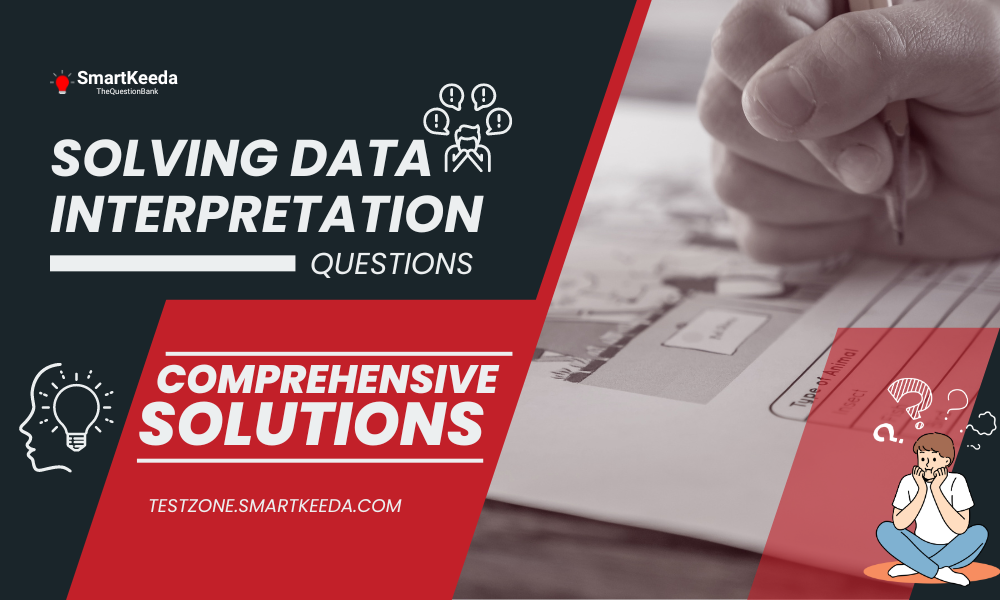
The Importance of DI Questions in Competitive Exams
- Also, scoring well in data interpretation questions can give candidates a competitive advantage, as it often accounts for a significant portion of the exam. High scores in this section can boost overall exam performance and improve candidates' chances of selection.
Understanding the Basics of Data Interpretation
- Tables: Tables organize data in rows and columns, making it easy to compare and analyze information.
- Charts: Charts and graphs, such as bar charts, line graphs, and pie charts, are used to visualize data trends and relationships.
- Textual Data: Sometimes, data is presented in paragraphs or textual descriptions that require careful reading and interpretation.
The process of data interpretation in competitive exams generally follows these steps
- Data Understanding: Read and understand the data presentation carefully, including labels, units, and the context provided.
- Problem Identification: Identify the type of problem or question being asked, whether it involves calculations, comparisons, trends, or predictions.
- Calculations: Perform calculations accurately, paying attention to units and any formulas required.
- Data Analysis: Analyze the data to draw meaningful insights and patterns. Look for relationships, trends, and outliers.
- Answer Presentation: Express your answers clearly and concisely, adhering to the format requested in the question.
Smartkeeda - Your DI Solution Partner
- Explanatory Solutions: Detailed solutions and explanations for each DI question are included. These explanations help candidates understand the thought process and techniques required to solve DI problems.
- Progress Tracking: Smartkeeda offer tools to track your progress. This includes performance analytics, score tracking, and recommendations for improvement.
- Mock Tests: I must say, Smartkeeda’s mock tests simulate the exact format and time constraints of the actual exams. These are essential for assessing your readiness and time management skills. Mock tests are easily accessible at https://testzone.smartkeeda.com/test/dashboard/data-interpretation/208.
- Study Material: In addition to mock tests, Smartkeeda offers study material and resources to improve your DI skills. Resources on DI can be found at https://www.smartkeeda.com/Quantitative_Aptitude/Arithmetic/DI_Mixed_Chart_No_55.
Step-by-Step Approach to Tackling DI Questions
- Read the Instructions and Data Presentation Carefully: Begin by carefully reading the instructions, titles, and any notes or labels accompanying the data presentation. Understand the context and the type of data being presented.
- Identify the Question Type: Determine the type of question being asked. Common DI question types include comparison questions, trend analysis, percentage calculations, and predictions. Knowing the question type will guide your approach.
- Start with Simple Observations: Begin by making simple observations about the data. Look for obvious trends, outliers, or significant points that stand out. Sometimes, you can answer questions without performing complex calculations.
- Check for Units: Don't forget to include units of measurement in your answer if they are relevant. This is especially important for questions involving quantities.
- Time Management: Manage your time wisely. Data interpretation questions often come with time constraints. If a particular question seems too time-consuming, consider skipping it and returning to it later if you have time remaining.
Types of Data Interpretation Questions
- Tabular Data Interpretation: Questions may ask candidates to calculate percentages, find averages, compare values, or make predictions based on the data presented in the table.
- Bar Chart or Bar Graph Data Interpretation: Data is represented in the form of bar charts, where the length or height of the bars represents values or quantities.
- Pie Chart Data Interpretation: Pie charts display data as sectors of a circle, with each sector representing a percentage of the whole.
- Mixed Data Sets: Some DI sets combine multiple types of data representations, such as tables, bar charts, and pie charts, to challenge candidates to integrate information from different sources.
- Caselet Data Interpretation: Caselet questions provide a brief scenario or situation, followed by a set of related questions.
- Data Sufficiency: In data sufficiency questions, candidates are given a question and a set of data statements. They must determine whether the given data is sufficient to answer the question or whether additional information is needed.
- There are many more types like Comparative Data Interpretation, Profit and Loss Data Interpretation, Market Share or Percentage Allocation, Time and Work Data Interpretation, Data Tables with Missing Values, etc.
Tips and Tricks for Speed and Accuracy
- Before diving into DI questions, ensure you have a solid understanding of the basic concepts used in data interpretation, such as percentages, ratios, averages, and growth rates.
- When you encounter the data presentation (table, chart, graph, etc.), take a moment to scan it and get a sense of the data's structure and trends. Note any outliers or unusual data points.
- In some cases, you can estimate values instead of calculating them precisely. Approximations can save time while maintaining reasonable accuracy.
- Look for shortcuts and techniques to simplify calculations. For example, you can use cross-multiplication to calculate percentages quickly.
- Time management is crucial. Allocate a specific amount of time to each DI set, and stick to it. If a question is taking too long, move on and return to it later if time permits.
Conclusion - Empowering Your DI Skills with Smartkeeda
- Plan a study schedule that incorporates regular mock test practice. Allocate specific days or time slots for taking mock tests. Consistency is key.
- When taking mock tests, create a testing environment similar to the actual exam. Sit in a quiet place, adhere to time limits, and eliminate distractions.
- After completing the mock test, thoroughly review your performance. Analyze your answers, including correct and incorrect ones, and understand where you went wrong.
- Smartkeeda mock tests come with detailed solutions and explanations for each question. Review these to understand the correct approach to solving DI questions.

Author : Rohit Sharma
Hi, I am Rohit Sharma, the head of the Law exams vertical at Smartkeeda and an alumnus of NLU Punjab. Having successfully cleared the CLAT exam twice, I am currently engaged in teaching Legal Reasoning on the LawEx YouTube channel. Moreover, I contribute by writing blogs that are specifically tailored to the CLAT exams.
FAQ’s
Though we have discussed it in detail in the blog, but to be sum up, Smartkeeda is one stop solution and one can rely to it completely.
Smartkeeda nt not only covers 14+ types of Date Interpretation Questions but also includes any new type which may come in the banking exams. They keep themselves abreast with the latest trend.
If you haven't already, sign up for an account on Smartkeeda's platform and familiarize yourself with the interface. Browse through the available resources and features. Attempt their free PDFs by which you can get a fair idea of their content and way of explanation. Believe me my friend, if you are genuinely preparing for bank exams, try their mock tests, you will never regret your decision.
If you have any queries, you can reach out at 7505332420 which will be available from 10 am to 6 pm (Mon. to Sat.). For any support related queries, feel free to write to us at help@smartkeeda.com, info@smartkeeda.com & help.smartkeeda@gmail.com.
Absolutely, Smartkeeda's DI resources are exclusively available on a mobile device and can be downloaded from https://play.google.com/store/apps/details?id=smk.smartkeeda and you can enjoy the learning.





